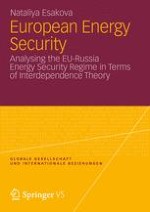Nataliya Esakova performs an analysis of the interdependencies and the nature of cooperation between energy producing, consuming and transit countries focusing on the gas sector. For the analysis the theoretical framework of the interdependence theory by Robert O. Keohane and Joseph S. Nye and the international regime theory are applied to the recent developments within the gas relationship between the European Union and Russia in the last decade. The objective of the analysis is to determine, whether a fundamental regime change in terms of international regime theory is taking place, and, if so, which regime change explanation model in terms of interdependence theory is likely to apply.
